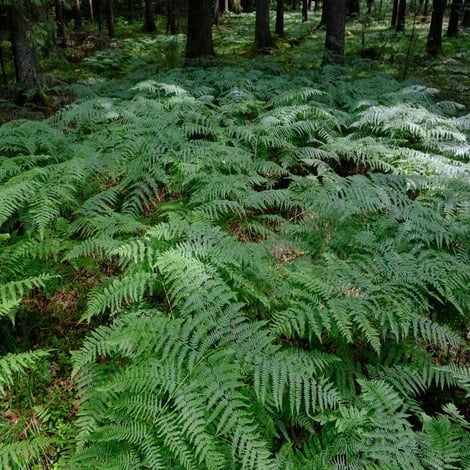Bracken
The ferny growth of bracken is a common sight in the UK countryside. It regrows each spring from underground stems and, if left unmanaged, can form dense colonies, so you may want to remove it from areas of your garden.

Quick facts
- Bracken’s botanical name is Pteridium aquilinum
- It is a herbaceous perennial, with fronds dying back in autumn and new growth appearing in spring
- Bracken spreads by rhizomes (underground stems) and windborne spores
- If you need to control bracken, non-chemical methods are effective, but it can take time to get rid of completely
Jump to
What does bracken look like?
Roots and dark
Is bracken a weed?
Bracken is native to the UK and is a valuable wildlife plant, providing shelter for mammals, reptiles, amphibians, birds and insects. It is a food source for many caterpillars, including those of the brown silver-line, small angle shades, orange swift, gold swift and map-winged swift moths.
It is also a useful material to have to hand in the garden. Fronds added to the compost bin slowly rot down to create a mulch with a lower pH level than many other mulches made from organic matter. This means it can safely be used around ericaceous (acid-loving) plants. Bracken stems are tough and slow to rot down though, so shred or chop them first to speed up the composting process. Dried bracken stems can also be used to protect tender plants over winter, including tree ferns.
However, if left unchecked, bracken can form dense colonies that prevent the growth of other plants (including natives). In gardens, this can cause unwelcome competition for garden plants and reduce biodiversity, so you may choose to control its spread.
Frequently asked questions about controlling bracken
Here are our answers to your most common questions about dealing with bracken:
How invasive is bracken?
Bracken is quite an invasive plant, able to spread into gardens by spores blown on the wind, by rhizomes growing across boundaries with open countryside, and by rhizome sections hidden amongst the roots of shared plants. As it isn't fussy about soil type and can grow well in all but very alkaline soils, it can quickly establish in a garden if introduced.
Do I need to get rid of bracken?
Not necessarily – you may choose to leave some bracken in areas of your garden where you don’t want, or struggle to grow, anything else, such as along a boundary with open countryside or on a steep bank. A valuable wildlife plant, it is great for supporting native moth caterpillars.
If your growing space is small, or if bracken is spreading into areas where you want other plants to grow, then it is a good idea to remove it.
What is the easiest way to kill bracken?
If you have bracken growing where it is not wanted, there are methods of controlling it:
- Pull out plants – removing by hand any young plants that grow far from existing clumps of bracken (and have likely grown from spores) is a quick and easy way to prevent them establishing in your garden. Hand-pull shoots growing from rhizomes that have spread into your garden. Regular checking and hand-pulling will be necessary if a lot of bracken is growing in adjacent ground. Hold stems near to ground level when pulling and wear thick gardening gloves to avoid cuts.
- Fork out plants – use a border fork to lift mature plants, making sure to insert deep enough to get as much of the rhizome out as possible. Repeated removal of new stems and sections of rhizome will weaken and eventually eradicate bracken. Position your fork at the base of the stems to minimise soil disturbance.
- Cut or crush stems – damage fronds by cutting them back or crushing them while shoots are still young and tender. Repeat this a few times during summer as stems grow back, to weaken the plant. Eradication using this method may take several years, but it can be used to clear large areas of bracken.
Should I use weedkiller?
As non-chemical control methods are effective, even if they are time-consuming, there is no need to use weedkillers. This is especially true in a garden situation, where bracken is usually only found in small clumps. Contact weedkillers are not an effective method of controlling bracken and even systemic products need timely and regular application to have any effect.
See also...
Get involved
The Royal Horticultural Society is the UK’s leading gardening charity. We aim to enrich everyone’s life through plants, and make the UK a greener and more beautiful place.